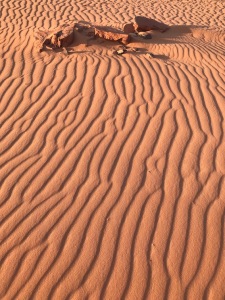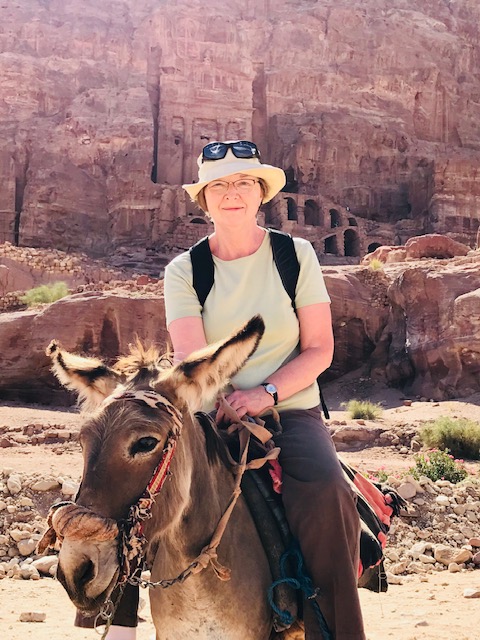This is the first of series of articles by Professor Katharine Lochnan, University of Toronto.
What is a desert? We think of it as a sandy, arid, inhospitable, place where camels are the mode of transportation, and oases essential for human life.
In July 2018 I visited two deserts featured in the Bible. The first is the Judean desert south of Jerusalem, which abuts the west side of the Dead Sea in Israel, the saltiest and lowest place on planet earth. The packed yellow sand is dry and hard, the light blinding, and the only shade and protection from the heat is provided by caves in the hills.
The second desert, the Rum desert, is completely different in character. It is located at the western edge of the Arabian desert, between the Dead Sea and the Red Sea. It is believed that Moses and the Israelites followed the ancient route through this desert in their search for the Promised Land.
It consists of soft pink sand which is blown about by the wind forming corrugated ripples and shifting mounds that are punctuated by rocky outcroppings from which you can see long vistas through endless, empty spaces, and view gorgeous sunsets.
If the Judean desert is penitential and pains the eyes, the Rum desert is sensuous and warms the heart. What they have in common is their remoteness, their dryness, and their silence. Both have acted as magnets to holy men since the dawn of time and have played major roles in Jewish and Christian spirituality.
Hidden away in the desert is one of the most beautiful cities ever built. Petra (meaning “rock”), nicknamed “the rose red city one of the Nabateans,” was carved out of pink sandstone cliffs over several millennia. It was once an important crossroads, where Near Eastern and Hellenistic traditions blended.
For centuries Petra was considered “lost” and its location was known only to the nomadic Bedouin for whom the desert remains home. It is approached through a long, winding pink canyon which opens out to become the forecourt of the great Treasury, a temple-like classical building whose façade is carved into the face of the rock. While it cannot be proven, it is thought that Jesus may have come here, and that Paul would have put it on his itinerary.
It was in the Judean desert that the Jewish Essenes created an ascetic community at Qumran to escape the politics and corruption of the Temple and the city of Jerusalem. There they wrote the Dead Sea Scrolls and stored them in covered jars in caves overlooking the Dead Sea.
John the Baptist may have spent time with the Essenes before he began baptizing in the River Jordan; Christ went into the Judean desert following his baptism and fasted and prayed for forty days and forty nights while wrestling with temptation.
The first Christian monks were known as anchorites. St. Antony the Great went out into the Egyptian desert c. 270 C.E. to escape the “fleshpots” of pagan Alexandria. Although he craved solitude, he was sought out by others who wanted to learn how to become anchorites. In 360 C.E. St. Athanasius of Alexandria wrote Antony’s biography. Later translated into Latin in 374 C.E., it became one of the best-known works in the Christian world and inspired many men and women to lead hermetic existences. At one time it was said that tens of thousands of anchorites were living in the Egyptian desert! Some formed eremitic communities, living alone and coming together on Sunday to celebrate the Eucharist. This led to the formation of the first cenobitic communities in which the monks lived communally.
Transmission towards Ireland
By the 5th century, Christianity had arrived in Ireland along with these early forms of Egyptian monasticism. The story of St. Antony was well known, and his attribute, the tau cross, can be found outside the church at Kilnaboy on the Burren. As Ireland did not have sandy deserts, the early anchorites looked for uninhabited places: their deserts consisted of remote, rocky, inhospitable areas that were seen to be cognate to the deserts of Palestine and Egypt. Thomas O’Loughlin, Professor of Historical Theology at the University of Nottingham, points out that the concept of historical accuracy, as we think of it, was not applied to the writing of ancient biographies. The little we know about the dates and lives of early saints comes from later hagiographies designed to demonstrate the regard with which they were held by later generations.
Some of the earliest accounts of saints and monastic settlements in Ireland can be found on the Aran islands. These geological extensions of the Burren were originally part of Úi Lochlainn territory. Their location on the edge of the known world, and the fact that there are three of them, must have had great symbolic significance for the early monks. Not only was there nothing between them and eternity, they could be seen to represent the doctrine of the Trinity which emerged at the end of the 4th century and was to become central to Celtic Christianity.
On the largest island, Inis Mór, St. Enda of Aran established the first Irish monastery at Killeaney around 500 C.E. Legend holds that he was a former warrior-king from Ulster, who was converted to Christianity by his sister, Saint Fanchea, an abbess. He went to Scotland, which was by then a great centre of monasticism, to study for the priesthood. After his brother-in-law, Aengus, King of Munster, gave him land in the Aran Islands, Enda went to live there as a hermit and formed an eremitic community.
The monks imitated the asceticism and simplicity of the desert hermits living alone in dry-stone huts known as ‘clochán’, sleeping on the ground, and eating together in silence. They embraced a hard life of manual labour, prayer, fasting and studied the scriptures. They survived by farming and fishing.
Part 2 of this essay will be posted next month.







This note may be appropriate to accompany Part (2) of the essay; From Petra to Petra Fertilis. Etienne Rynne who displays links to both counties Clare and Galway, edited a work entitled; North Munster Studies (Thomond Archaeological Society). Rynne also composed an essay for the 1967 title – The Tau Cross at Kilnaboy; Pagan or Christian?
While it is impossible to capture the range of Rynnne’s article, he notes the Tau Cross was ‘lost/stolen’ during the 19th century, before being ‘re-discovered’ by the County Clare Antiquarian, George U MacNamara c 1900. Rynne also noted how the possible origins of The Tau Cross has engaged the minds of many scholars for over 150 years and more – edward
LikeLiked by 1 person
Pingback: Colman’s Burren hermitage | Clan Ólochlainn